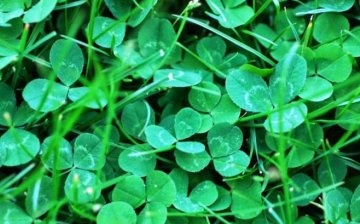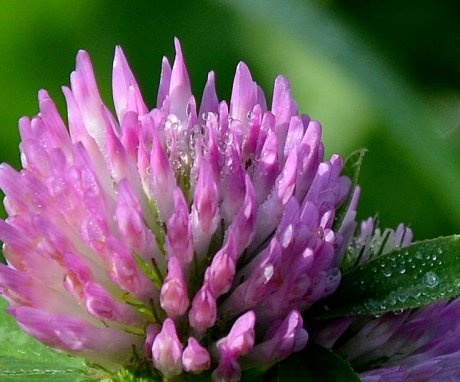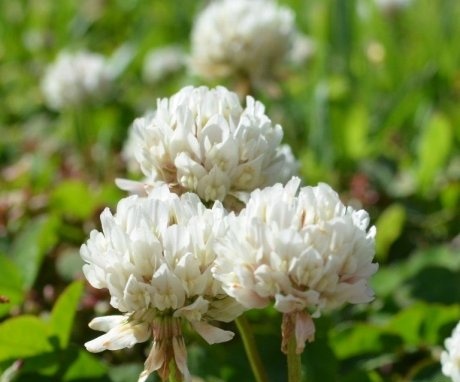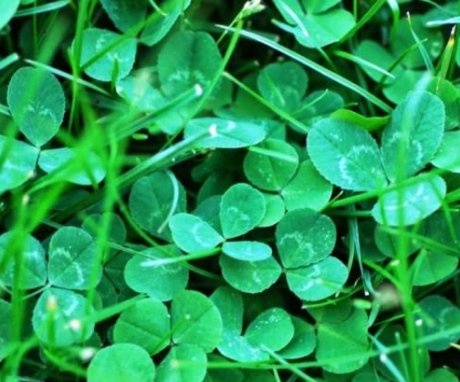What is clover as a siderat, what is it used for
When growing crops, soil fertilization is of great importance. For this, not only organic and mineral fertilizers can be used, but also green manure.
The latter make it possible to make high-quality and inexpensive feeding. For this purpose, you can use clover as a siderat.
Features of using clover as a green manure
This plant, as a precursor, has a beneficial effect on the development of many agricultural crops. These include berries eggplant, cucumbers, cabbage, onions, lettuce, peppers, various root vegetables and many other plants.
However, there are exceptions - legumes. Peas, beans, the beans should be planted no earlier than four years after the clover has grown on the site.
There is another way to use this green manure - planting between fruit trees in the garden. A strong layer of turf retains moisture well, protects the roots from sudden temperature fluctuations and helps supply trees with nutrients.
Advantages and disadvantages
Clover is effective when used for soil preparation. He has such advantages:
- The root system is actively growing and actually cultivates the land: it drains the soil, loosens it, and cultivates clay soil, making it permeable to air and water.
- Improves the adhesion of soil particles. Clover can be planted on hillsides to stop shedding. It can be applied in this way on any soils, including sandy ones.
- Growing, this plant forms a dense turf, which plays an important role in protecting the soil from freezing in winter or from drying out in hot summer. Such land will not be washed out by rains.
- Growing clover prevents weeds from growing.
- The root system interacts with the nodule bacteria. As a result, atmospheric nitrogen is processed into such a form that other plants can use it.
- Phosphorus can be present in soil in a form that is difficult for plants to absorb. The root system of clover recycles this substance, making it available to other plants.
- Clover carpet can regulate soil temperature. In hot weather, it makes it impossible to overheat the surface, and in cold weather it protects it from freezing. As a result, the roots of plants growing next to it do not experience sudden temperature jumps.
- If clover grows on the site, then the excretion of its roots helps to fight some pests, oppressing them. An example is the impact on the wireworm, which is dangerous for potato planting.
- This plant not only helps to improve the quality of the soil, but is also a good honey plant. Clover attracts insects by contributing to pollination of nearby plants
- Clover stems and flowers are high-quality biofertilizers. It provides plants with potassium, phosphorus, starch.
The use of this plant also has certain disadvantages:
- Clover develops slowly, it reaches its greatest efficiency as a result of long-term cultivation.
- The clover development rate is lower than that of other green manure plants.
- Clover does not grow well in too acidic or salty soils. He does not like overly moist soil.
- This plant is capable of actively growing.After sideration, it can hinder the development of the main plant.
It is usually damp where it grows. These conditions attract slugs and snails, harming the surrounding plants.
Views
All types of clover, which are described below, require more than a year for greening. Red needs to be grown 2-3, pink - 6, and white needs 20 years.
White (creeping)
It also has the names: Amoria creeping or White Kashka. This perennial plant has a strong tap root system. The stem is creeping. It spreads by taking root in the nodes. Tripartite leaves grow on long roots. In some cases, their length can be up to 30 cm.
Clover heads are spherical. Their color is most often white, but sometimes pink. Fruits appear in late June or early July. They are flat, oblong beans. In each of them, you can find 3-4 seeds of orange or gray-yellow color.
Red (meadow)
This perennial plant can grow up to 15-55 cm. Red meadow clover has a rising stem. The leaves have a trifoliate shape. The capitate inflorescences are loose. They are pink-red in color, sometimes it can be white. Fruits appear in September-October. They are single-seeded beans.
Pink
This species is hybrid. It is a perennial herb. Its height is 30-80 cm. Shoots are tubular ascending. The leaves are inverted, ovoid or oval in shape.
Dense terry inflorescences. They have a light pink color in spring, and by the end of summer you can see a brown tint. The fruit has a flat oblong shape. Ripening time is in late summer or early autumn. It contains 1 to 3 dark olive seeds.
Landing dates
Clover can be sown throughout the season from early spring to late fall.
If planting occurs in October or November, you must do it at temperatures less than 15 degrees. Otherwise, seedlings will appear that will not withstand the winter frosts and will die.
How to plant clover as a siderat
This plant grows well on podzolic, clayey or peaty soils. Sowing is done as follows:
- It is necessary to keep the seeds in warm water or in a weak solution of manganese for 12 hours. Then they must be dried to such an extent that they are easily separated from each other.
- Clover does not like acidic soils. If it needs to be sown on such land, liming needs to be done. It will reduce the acidity index and add calcium necessary for plant growth to the soil.
- Before carrying out work, the area must be cleaned. In this area, weeds are removed and garbage is removed.
- The soil must be loosened before planting. To do this, you can dig it up with a shovel or use a cultivator for loosening.
- In the event that the soil is depleted, it is necessary to apply fertilizer. At the same time, for each square meter, you will need to add 4-5 kg of humus, superphosphate 30 g and potassium salt 20 g.
- In order to evenly sow the area, the seeds are mixed with sand in a ratio of 1: 3 before planting. In this case, sowing can be done in one of two ways: spread the mixture evenly over the area or sow in grooves located at a distance of 15 cm from each other.
After sowing, it is recommended to compact the soil (for this, it can, for example, be rolled over).
Care
When growing clover, there is no need for complex care. In the first year, regular watering is necessary. It is recommended to do it using a hose with a fine mesh nozzle. During the season, you need to fertilize with mineral fertilizers once or twice. This will help make the greens appear lush and silky.
While the clover has not yet grown, it requires regular loosening of the soil and weeding from weeds.
Liquid manure can be used to feed a young plant.To do this, the mullein is diluted with water in a ratio of 1: 2 and left to ferment under a film for several days. The resulting mixture is diluted in a ratio of 1: 5 and used for irrigation.
Mowing
In order to be able to mow a clover, it must grow for at least two years. It is repeated several times during the season. The first mowing takes place at the time when the buds begin to form. This usually happens in July or August. At this time, clover is most rich in nitrogen.
The last mowing should be done in the fall at such a time that before the winter cold the clover has time to restore its aboveground part.
In the case when the sowing was carried out in August, the clover is left to grow until the onset of spring. In this case, they will need to be cut to the root in April or May.
It must be remembered that if a lot of mown greens are used for fertilization, this can lead to soil acidification. Before starting treatment, it is necessary that the grass has dried for several days.
Making fertilizer from green mass
The beveled clover is first left on the ground and chopped finely with a shovel blade. Then it is moistened with warm water or a fermented herbal solution is used for this purpose. Thus, an environment will be created in which microorganisms can act to ensure the decomposition of grass residues.
The leftovers are left for 2-3 days, then a layer of garden compost with a thickness of about 1.5 cm is poured on them. After 10-15 days, depressions are made in the rotted mixture and the main culture is planted.
Sometimes the cut and cut plant is dried in the sun for several days, and then it is mixed with the top layer of earth.
When and how to bury
The cuttings can be used in several ways:
- As a fertilizer.
- As a mulch, helping to retain moisture in the topsoil.
- Make compost from a mixture of clover and other plants cut with it.
- Mow, grind and stir with the ground.
Green manure is buried only in the latter case. However, this should not be done immediately after mowing. In this case, the abundance of greenery can acidify the soil. Buried in a few days after the cut clover dries up.
When using the plant as compost or mulch, it is left on the surface of the ground.
Reviews of gardeners
- Ivan Nikolaevich: “Clover can, of course, grow on its own. However, after being mowed three times during the season, it will quickly fade away. This will happen primarily due to the fact that the root weakened. I give him time for the seeds to ripen and crumble, and only after that I mow. If you mow twice a season, then the second time should only occur after the seeds have ripened. "
- Inna Petrovna: “I used clover as a green manure in a flower bed. I removed it and roots to a depth of half a shovel bayonet. I checked the ground and saw that in the depths there were still living clover roots. This means that it will continue to grow in the flowerbed. I planted tulips, but I know that the clover has not been removed from the flower bed. "
- Sergey Ivanovich: “After collecting potatoes, I plant clover here. Now it will be possible to plant here again only after two years. From my own experience, I was convinced that clover increases the yield of potatoes and prevents weeds from growing. After it, the earth remains loose. "
Conclusion
Clover is not only able to improve soil fertility, but also protect the plant from weeds, help nourish fruit trees in the garden, attract pollinating insects, and much more. In order to apply it, you need to know the characteristics of growth and use.
Related videos:












It turns out that if you plant clover on the site, then you cannot plant a garden for two years. Therefore, it is better to plant this green manure not over the entire area, but on a small part. Gradually, over several years, improving the soil of the entire garden.
In my opinion, this is akin to planting lupins in the garden.No, they are both beautiful and useful. But then you can't get rid of them, but they scatter in an instant. So here too - somehow my clover grew by itself. And how I then suffered to lime it. What is the point of planting siderat in order to get rid of it for a long time and painfully?
Clover as a siderat is quite an interesting option, given the unpretentiousness of this plant. I think this plant is suitable for most regions of our country, and the clover itself can be useful as animal feed.